

3 benefits a smart city can gain from smart infrastructure. The Internet of Things is sweeping across the globe at breakneck speeds, and before we know it, our entire lives will be facilitated by connected technology.
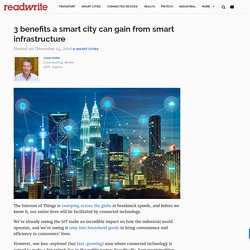
We’re already seeing the IoT make an incredible impact on how the industrial world operates, and we’re seeing it seep into household goods to bring convenience and efficiency to consumers’ lives. However, one less-explored (but fast-growing) area where connected technology is poised to make a big splash lies in the public sector: Specifically, how municipalities incorporate smart technology into their environments to save money, enhance the lives of their constituents, and entice the best and brightest businesses to set up shop within their borders. Living in a Smart City Imagine using a digital voice assistant like Siri to buy tickets for a big concert. Then, when you pull up to the municipal garage outside the arena, a kiosk tells you exactly where the nearest vacant parking spot is, making the experience a stress-free breeze. 1. 2.
£5.4 million centre will help transform the UK’s construction sector for the digital age. The Centre is a partnership between the Department of Business, Energy & Industrial Strategy and the University to support the transformation of the construction sector using digital technologies to better plan, build, maintain and use infrastructure.
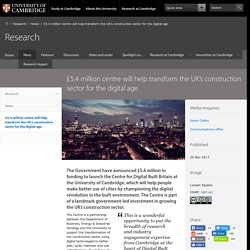
It will focus on the ongoing transformation of the built environment through the digital tools, standards and processes that are collectively known as Building Information Modelling (BIM). What is Smart Infrastructure? - ISN Conference. Obviously there no one definition, but this one by Cambridge Centre for Smart Infrastructure and Construction covers the essence of smart infrastructure.
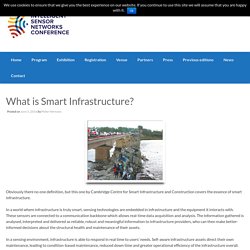
In a world where infrastructure is truly smart, sensing technologies are embedded in infrastructure and the equipment it interacts with. These sensors are connected to a communication backbone which allows real-time data acquisition and analysis. The information gathered is analysed, interpreted and delivered as reliable, robust and meaningful information to infrastructure providers, who can then make better-informed decisions about the structural health and maintenance of their assets.
In a sensing environment, infrastructure is able to respond in real time to users’ needs. Self-aware infrastructure assets direct their own maintenance, leading to condition-based maintenance, reduced down time and greater operational efficiency of the infrastructure overall. Definition by CSIC. Centre for Smart Infrastructure and Construction. Updating Infrastructure is Essential to Building Smart Cities.
This story was originally published by Data-Smart City Solutions.
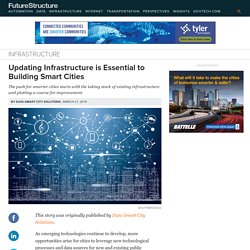
Smart Cities Challenge. Minister's Message The Honourable Amarjeet Sohi It is with great excitement that we have kicked off the Smart Cities Challenge.
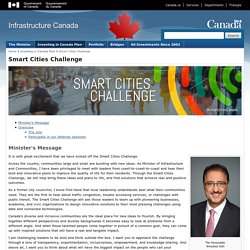
Across the country, communities large and small are bursting with new ideas. Australia Smart Cities and Infrastructure Forum. The inaugural Australia Smart Cities and Infrastructure Forum held in December 2016 was a resounding success, with over 100 city leaders and industry stakeholders coming together for meaningful exchange to catalyze Australia smart city developments.

Building on the success, Clariden Global is will be hosting an even bigger 2nd Australia Smart Cities and Infrastructure Forum this 15 – 17 November 2017, in Melbourne, Australia and we are proud to welcome you back. This forum will be the platform to bring together government agencies, city councils and industries to discuss strategies that can help you to identify and create the competitive edge in transforming into a smart city. The forum will also provide an unprecedented avenue for industries to meet with key departments in local, state and federal government. This forum will explore the key initiatives, issues and opportunities lying ahead in developing the Future Cities of Australia.
Get involved with the Smart Infrastructure Hub in Leipzig. Smart Infrastructure. The infrastructures of the future The use of technology and industry generate pollution that affects our natural environment and can be harmful to people.
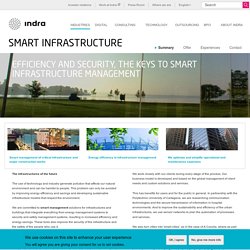
This problem can only be avoided by improving energy efficiency and savings and developing sustainable infrastructure models that respect the environment. We are committed to smart management solutions for infrastructures and buildings that integrate everything from energy management systems to security and safety management systems, resulting in increased efficiency and energy savings.
These tools also improve the security of the infrastructure and the safety of the people who use it. To implement these applications, we have extensive experience and expertise in Smart Infrastructure. Specific solutions for each client We work closely with our clients during every stage of the process. This has benefits for users and for the public in general.
But we are not just modernizing cities in Spain. Infrastructure & Technology - Amsterdam Smart City. The Payoff and Peril of Smart Infrastructure – Brink – The Edge of Risk. How smart infrastructure benefits a smart city. One area where connected technology is poised to make a big splash is in the public sector and how municipalities incorporate smart technology into their environments to save money, enhance the lives of their constituents, and entice the best and brightest businesses to set up shop within their borders.

Too often, though, city departments dive headfirst into the realm of connected technology without coordinating their efforts. For example, the utilities department will deploy one network for its smart meters, while the department of transportation uses a different one for its energy-efficient streetlights. Ultimately, this results in a variety of compatibility issues that leave cities with headaches and high costs. City departments must work in tandem when deploying IoT technologies, keep network longevity in mind, and strive to keep things as streamlined as possible. Smart infrastructure for Smart Cities. [EXTRACT FROM "Smart Cities, Smart mobility"]* Source: Smart Cities, Smart mobility, by Luckas Nekermann with Tim Smedley - p.45 – 46 2017 How do we get from ‘dumb’ building to smart infrastructure?
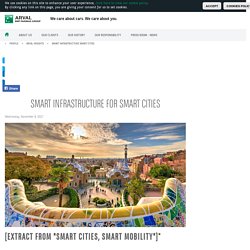
How do we turn highways into walkways and parking lots back into parks? It begins by understanding that building our way out of congestion is simply not an option. (…) I’ll take it a step further. The smartest of cities are the ones that are willing to fight against a century of car-centricity, and for a refocusing on quality of life. Barcelona is even more ambitious in its focus on liveability, traffic reduction and air quality improvement.
Smart Cities - Infrastructure & Finance. The future of smart cities will be shaped by the Internet of Things as a networking technology and by smart data as a forecasting technology.

For example, it will be possible to coordinate power generation and power demand more precisely than ever before. This development will make increasing decentralization manageable, merge the markets for heating and electricity, and integrate industrial facilities, buildings, and vehicles as energy suppliers. One step in this direction is offered by MindSphere, an open, cloud-based IoT operating system from Siemens that offers both connectivity and a range of industrial applications so that any enterprise, regardless of industry or size, can begin analyzing data to optimize their operations.
Smart Infrastructure Design for Smart Cities - IEEE Journals & Magazine. What is Smart Infrastructure? — Cambridge Centre for Smart Infrastructure and Construction.